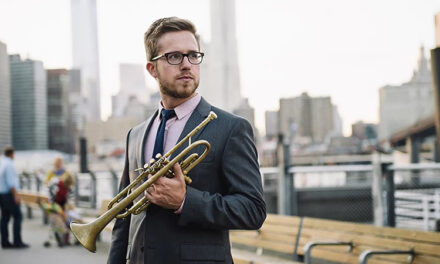The Young Artists Orchestra and three young soloists propelled the 51st season of the Eastern Music Festival toward its conclusion with some highly skilled playing of music that was neither safe nor standard, treating the audience at Guilford College’s Dana Auditorium to a non-warhorse program that was both entertaining and satisfying. The program contained music mainly from the early 20th century — Walton, Nielsen, Bartók and Stravinsky — and showed a wide variety of composition that generally drew the curtain on late 19th century Romanticism and set the transition into more modernism.
The first half of the program was a showcase for soloists and orchestra, and the second half for full orchestra. More than 150 young people, as young as 13 years of age and from many states and as far away as China, Taiwan, Hong Kong and Germany, were in this year’s Young Artists Orchestra, with nearly half taking part in the opening section of the program, under the direction of José-Luis Novo, and the other half forming the orchestra for Bartók and Stravinsky, under the direction of Thomas Hong. Three of the top players were soloists in the first part of the program.
The one selection that was not from the early 20th century opened the concert and was perhaps the best of the evening — Carl Maria von Weber’s Clarinet Concerto No. 1 in F-minor, Op. 73, from which Hilary Zirkle played the allegro movement. A 20-year-old senior at Peabody Conservatory, Ms. Zirkle played with great composure and beautiful tone throughout, negotiating tricky runs and startling intervals with ease. She offered a range of dynamics, and her sustained notes, especially at the top of the scale, were sweetly played.
Tiffany Laraia, an 18-year-old violist who has been a guest on public radio’s “From the Top,” played the andante comodo movement from William Walton’s Viola Concerto, and she met the demands of the score quite well, especially the nimble fingering and lengthy double-stopped passages. The piece occasionally calls for lines played initially in a lower register and then repeated an octave higher, and the balance between soloist and orchestra seemed weighted too heavily toward the orchestra at times, most notably when she played in the lower registers.
The third soloist was flutist Lauren Osaka, 21, from San Jose, California, who also has appeared on “From the Top.” She played the allegro moderato movement from Carl Nielsen’s Concerto for Flute and Orchestra, which opens with a lively solo line, almost dance-like. Ms. Osaka provided especially nice tone in her solo passages, and she engaged in a nice dialog with Peter Bauer on clarinet and with Caleb Ketcham on bass trombone. She, too, had a sweet sound, never shrill or breath-y.
Except for the slight imbalance between orchestra and soloist in the Walton excerpt, Novo brought out a rich sound from his players, quite sympathetic to the demands of accompanying a solo instrument. The players produced a clean, crisp sound that was most professional.
Béla Bartók’s splashy Dance Suite, composed in 1923, opened the second half of the concert. The six-movement piece is filled with nervous energy and shows Eastern influences more than once, while also containing passages (notably in the opening moderato movement) that recall portions of such works as Rite of Spring. Parts of the suite are quite exciting, and parts are more introspective, and all received a fine reading, as directed with both intensity and flair by Hong, assistant conductor of the Pittsburgh Symphony. Brass and winds combine with percussion to provide some emphatic moments, contrasting with occasional solo and small ensemble passages for treble winds such as clarinet and flute.
Of particular note was the middle section, which whirled about with its lively Eastern sound. But this section also conveys the same feeling as an impression of traffic in the city, not unlike Gershwin’s “American in Paris” that was composed five years later. Entrances and cutoffs were precise throughout, even given the tricky rhythms, and staccato attacks were uniformly excellent.
The concert concluded with a fine performance of Igor Stravinsky’s Firebird Suite (the 1919 version), and again the young players acquitted themselves with distinction. Several players merit special praise: first cellist Wesley Hornpetrie and concertmistress Leah Alexander (from Cary) played nice exposed lines early in the suite and teamed with oboist Jonathan DeBoer midway through. DeBoer and bassoonist Joseph Cannella had lovely passages in the “Berceuse” section, and Philip Koonce (from Charlotte) provided just the right mellow tone on French horn in the familiar solo line that opens the beautiful finale, an elegant 14-note sequence that is one of the best known passages for French horn in the repertoire.
Firebird also is an exciting piece, especially the “Infernal Dance” section. The second section (“Firebird and its Dance”) brings to mind the chickens portion of Pictures at an Exhibition and features a prominent line in the xylophone, played well by Rob Cosgrove. The whole piece came to a thrilling conclusion, quite well performed by the orchestra.
These young players could be in our professional orchestras in the future, and it is possible that we will hear from the soloists in the future, too, especially Ms. Zirkle. They certainly showed their considerable musical skills as part of the Eastern Music Festival.













